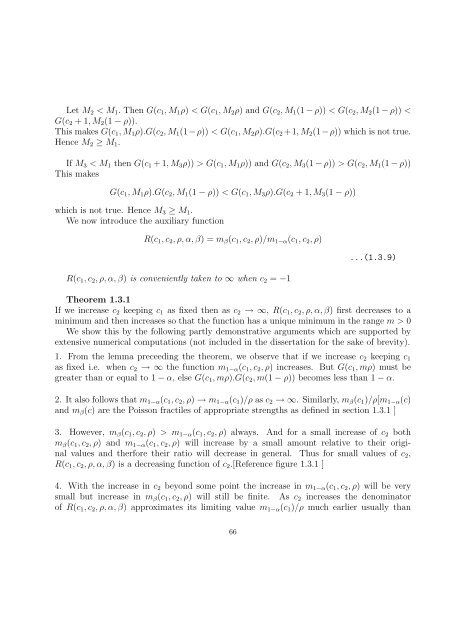Multiattribute acceptance sampling plans - Library(ISI Kolkata ...
Multiattribute acceptance sampling plans - Library(ISI Kolkata ...
Multiattribute acceptance sampling plans - Library(ISI Kolkata ...
Create successful ePaper yourself
Turn your PDF publications into a flip-book with our unique Google optimized e-Paper software.
Let M 2 < M 1 . Then G(c 1 , M 1 ρ) < G(c 1 , M 2 ρ) and G(c 2 , M 1 (1 − ρ)) < G(c 2 , M 2 (1 − ρ)) <<br />
G(c 2 + 1, M 2 (1 − ρ)).<br />
This makes G(c 1 , M 1 ρ).G(c 2 , M 1 (1−ρ)) < G(c 1 , M 2 ρ).G(c 2 +1, M 2 (1−ρ)) which is not true.<br />
Hence M 2 ≥ M 1 .<br />
If M 3 < M 1 then G(c 1 + 1, M 3 ρ)) > G(c 1 , M 1 ρ)) and G(c 2 , M 3 (1 − ρ)) > G(c 2 , M 1 (1 − ρ))<br />
This makes<br />
G(c 1 , M 1 ρ).G(c 2 , M 1 (1 − ρ)) < G(c 1 , M 3 ρ).G(c 2 + 1, M 3 (1 − ρ))<br />
which is not true. Hence M 3 ≥ M 1 .<br />
We now introduce the auxiliary function<br />
R(c 1 , c 2 , ρ, α, β) = m β (c 1 , c 2 , ρ)/m 1−α (c 1 , c 2 , ρ)<br />
R(c 1 , c 2 , ρ, α, β) is conveniently taken to ∞ when c 2 = −1<br />
...(1.3.9)<br />
Theorem 1.3.1<br />
If we increase c 2 keeping c 1 as fixed then as c 2 → ∞, R(c 1 , c 2 , ρ, α, β) first decreases to a<br />
minimum and then increases so that the function has a unique minimum in the range m > 0<br />
We show this by the following partly demonstrative arguments which are supported by<br />
extensive numerical computations (not included in the dissertation for the sake of brevity).<br />
1. From the lemma preceeding the theorem, we observe that if we increase c 2 keeping c 1<br />
as fixed i.e. when c 2 → ∞ the function m 1−α (c 1 , c 2 , ρ) increases. But G(c 1 , mρ) must be<br />
greater than or equal to 1 − α, else G(c 1 , mρ).G(c 2 , m(1 − ρ)) becomes less than 1 − α.<br />
2. It also follows that m 1−α (c 1 , c 2 , ρ) → m 1−α (c 1 )/ρ as c 2 → ∞. Similarly, m β (c 1 )/ρ[m 1−α (c)<br />
and m β (c) are the Poisson fractiles of appropriate strengths as defined in section 1.3.1 ]<br />
3. However, m β (c 1 , c 2 , ρ) > m 1−α (c 1 , c 2 , ρ) always. And for a small increase of c 2 both<br />
m β (c 1 , c 2 , ρ) and m 1−α (c 1 , c 2 , ρ) will increase by a small amount relative to their original<br />
values and therfore their ratio will decrease in general. Thus for small values of c 2 ,<br />
R(c 1 , c 2 , ρ, α, β) is a decreasing function of c 2 .[Reference figure 1.3.1 ]<br />
4. With the increase in c 2 beyond some point the increase in m 1−α (c 1 , c 2 , ρ) will be very<br />
small but increase in m β (c 1 , c 2 , ρ) will still be finite. As c 2 increases the denominator<br />
of R(c 1 , c 2 , ρ, α, β) approximates its limiting value m 1−α (c 1 )/ρ much earlier usually than<br />
66
















